Iceberg Principle冰山原则
冰山理论知识管理
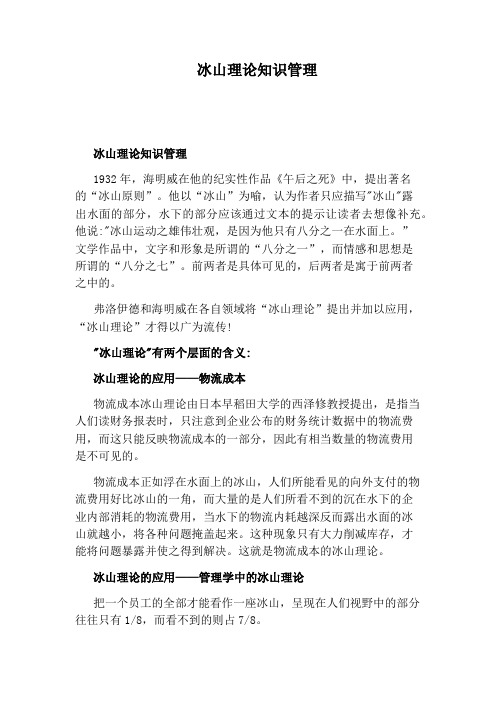
冰山理论知识管理冰山理论知识管理1932年,海明威在他的纪实性作品《午后之死》中,提出著名的“冰山原则”。
他以“冰山”为喻,认为作者只应描写"冰山"露出水面的部分,水下的部分应该通过文本的提示让读者去想像补充。
他说:"冰山运动之雄伟壮观,是因为他只有八分之一在水面上。
”文学作品中,文字和形象是所谓的“八分之一”,而情感和思想是所谓的“八分之七”。
前两者是具体可见的,后两者是寓于前两者之中的。
弗洛伊德和海明威在各自领域将“冰山理论”提出并加以应用,“冰山理论”才得以广为流传!"冰山理论"有两个层面的含义:冰山理论的应用——物流成本物流成本冰山理论由日本早稻田大学的西泽修教授提出,是指当人们读财务报表时,只注意到企业公布的财务统计数据中的物流费用,而这只能反映物流成本的一部分,因此有相当数量的物流费用是不可见的。
物流成本正如浮在水面上的冰山,人们所能看见的向外支付的物流费用好比冰山的一角,而大量的是人们所看不到的沉在水下的企业内部消耗的物流费用,当水下的物流内耗越深反而露出水面的冰山就越小,将各种问题掩盖起来。
这种现象只有大力削减库存,才能将问题暴露并使之得到解决。
这就是物流成本的冰山理论。
冰山理论的应用——管理学中的冰山理论把一个员工的全部才能看作一座冰山,呈现在人们视野中的部分往往只有1/8,而看不到的则占7/8。
职业化素质既然有大部分潜伏在水底,就如同冰山有八分之七存在于水底一样,正是这八分之七的隐性素质部分支撑了一个员工的显性素质部分!员工素质的“水下部分”包括职业意识、职业道德、职业态度,是隐性的,即处在水面以下,如果不加以激发,它只能潜意识地起作用,这方面处于冰山的最下层,是人力资源管理中经常被忽视的,也经常被员工被人所忽视。
然而,如果员工的隐性素质能够得到足够的培训,那么对员工的提升将是非常巨大的,同时对企业的影响也将更加深远。
大部分企业非常重视员工的显性素质培训,诸如职业技能培训等等,好像这些培训的效果能够立竿见影地凸现出来。
冰山原则 在 一个干净、明亮的地方中的表现

Functions in A Clean Well - lighted Place
人物介绍
Ernest Miller Hemingway 美国小说
家。海明威出生于美国伊利诺伊州芝加哥 市郊区的奥克帕克,晚年在爱达荷州凯彻 姆的家中自杀身亡。海明威被誉为美利坚 名族的精神丰碑,并且是“新闻体”小说 的创始人,他的笔锋一向以“文坛硬汉” 著称。海明威的写作风格以简洁著称,对 美国文学及20世纪文学的发展有极深远的 影响。
• Using of symbols • Conventional symbols 1.The clean,well - lighted café represents light,order and pleasantness. 2.Darkness is a symbol of fear and loneliness. 3.The light symbols comfort and company of others.
A Clean Well - lighted Place is justly regarded as one of the stylistic masterpiece of Ernest Hemingway’s short stories. What stands out about this story is its minimalism极简主义. Known for simple sentences and simple diction ,Hemingway outdoes himself in this famous short story.
works
The Old Man and the Sea
(Man is not made 获得 for defeat. A man can be destroyed but not defeated ) 1953年普利策奖及1954年诺贝尔文学奖。
冰山理论(icebergtheory)
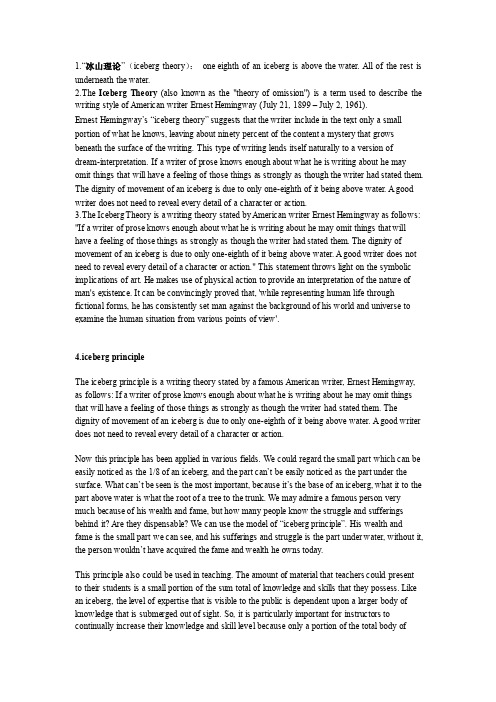
1.“冰山理论”(iceberg theory):one eighth of an iceberg is above the water. All of the rest is underneath the water.2.The Iceberg Theory (also known as the "theory of omission") is a term used to describe the writing style of American writer Ernest Hemingway (July 21, 1899 – July 2, 1961).Ernest Hemingway’s “iceberg theory” suggests that the writer include in the text only a small portion of what he knows, leaving about ninety percent of the content a mystery that grows beneath the surface of the writing. This type of writing lends itself naturally to a version of dream-interpretation. If a writer of prose knows enough about what he is writing about he may omit things that will have a feeling of those things as strongly as though the writer had stated them. The dignity of movement of an iceberg is due to only one-eighth of it being above water. A good writer does not need to reveal every detail of a character or action.3.The Iceberg Theory is a writing theory stated by American writer Ernest Hemingway as follows: "If a writer of prose knows enough about what he is writing about he may omit things that will have a feeling of those things as strongly as though the writer had stated them. The dignity of movement of an iceberg is due to only one-eighth of it being above water. A good writer does not need to reveal every detail of a character or action." This statement throws light on the symbolic implications of art. He makes use of physical action to provide an interpretation of the nature of man's existence. It can be convincingly proved that, 'while representing human life through fictional forms, he has consistently set man against the background of his world and universe to examine the human situation from various points of view'.4.iceberg principleThe iceberg principle is a writing theory stated by a famous American writer, Ernest Hemingway, as follows: If a writer of prose knows enough about what he is writing about he may omit things that will have a feeling of those things as strongly as though the writer had stated them. The dignity of movement of an iceberg is due to only one-eighth of it being above water. A good writer does not need to reveal every detail of a character or action.Now this principle has been applied in various fields. We could regard the small part which can be easily noticed as the 1/8 of an iceberg, and the part can’t be easily noticed as the part under the surface. What can’t be seen is the most important, because it’s the base of an iceberg, what it to the part above water is what the root of a tree to the trunk. We may admire a famous person very much because of his wealth and fame, but how many people know the struggle and sufferings behind it? Are they dispensable? We can use the model of “iceberg principle”. His wealth and fame is the small part we can see, and his sufferings and struggle is the part under water, without it, the person wouldn’t have acquired the fame and wealth he owns today.This principle also could be used in teaching. The amount of material that teachers could present to their students is a small portion of the sum total of knowledge and skills that they possess. Like an iceberg, the level of expertise that is visible to the public is dependent upon a larger body of knowledge that is submerged out of sight. So, it is particularly important for instructors to continually increase their knowledge and skill level because only a portion of the total body ofknowledge will appear to be available; the same goes to learning. What the teacher could teach us is very limited, so if we want enrich our knowledge; we have to learn to use what we have learned to explore the unknown things.5.What do you know about Hemingway’s iceberg theory of writing?Hemingway and his "tip of the principle of"20 to 30 years in the prevalence of this century on behalf of the "Lost Generation" on behalf of recognized literary genre known as the United States is the writer of the twentieth century the first half of the most talented novelist Ernest genius. Hemingway. If one sentence summed up his people, and that is: a love of sports and sports a tough guy; A sophisticated reporter world; all the scars of a fighter; a Spanish bullfight fan; not only a good drink Also pay attention to the spirits of life gourmet. Hemingway's thinking is very deep and unique perspective, the poet Allen? Tate as saying that he had "an extremely delicate heart and a strong selective observation capacity." He Aoqi Te in the art of deep thinking, "the tip of the principle of" can be described as the most representative and most well-known.In 1932, Ernest Hemingway in his works of documentary "Death in the afternoon", the first time literature than done floating in the ocean on the tip, he said: "the tip of the movement's magnificent, because he was only eighth in the On the surface of the water. "Since then, many have made such an analogy. This image of Hemingway analogy, literary criticism aroused interest in the sector. As a result, the so-called "tip of the principle of" literary criticism has become involved in the study of Hemingway created one of the important issues. It can be said that "the tip of the principle of" Hemingway was on his many years of experience summed up the image, he is dealing with the relationship between art and life followed by the basic norms.In that case, what is "the tip of the principle of"?In this regard, Western critics carried out a great deal to explore. Let us take a look at how they are understandable. American Academy of Arts Critics pointed out that the horse Cosme: "Y ou extracted from the life of those who arouse feelings of their own distinctive details, if you are not on the terrorist atrocities and out of touch with reality, and in accordance with the proper order to accurately describe the details, then Y ou write will still arouse the reader's emotional things to come. This is the Ernest Hemingway in his early close-up followed in the method of its own to limit the scope is very successful. Even in its scope, he is also Successful, as he described the picture show with a wide range of implied power. "Betts Speaking on British critics of the Hemingway short story, said:" The master of the art implies, that a word or two for more than two different The Art of the matter, then the short story house to do the work completed more than half. "Elder critic of the United States of Hemingway's" tip of the principle of "negative, he thought it was" evasive tactics, "" A way to create a mood of emotional atmosphere. "The community started to criticize the various ways that can help us understand the "tip of the principle". However, if further from the aesthetics and poetics of "the tip of the principle of"in-depth understanding, it is clear that each of Appeal on is not enough.The "tip of the principle of" Hemingway in his "Death in the afternoon," there is an explanation, he wrote: "If he wanted to write an essayist for the very few things in mind, he knows he may omit things, so readers As long as the writers write the true will of the strong feeling that he had omitted, the author seems to write out like. "Obviously, to emphasize here that the writer is omitted, Shui Mianxia advocate of the" seven eighths "should be left to The reader to feel. According to the interpretation of Hemingway, the "tip of the principle of" a rough generalization: the so-called "tip of the principle", is to use simple language to shape a distinctive image of their own feelings and ideas, emotions and buried it in the image of the maximum, So that it is full of emotion hidden, and deep thinking of the night and not hidden, so that literature can be emotional and can be thought of a clever combination of clear-cut image for readers to discover the feelings of the ideological significance of the work.Concise text, the image of the distinctive, rich and deep emotional thinking is a "tip of the principle of" the four basic elements. Specifically, text and image is the so-called "eighth" and feelings and ideas is the so-called "seven eighths." The first two concrete is visible, the latter two are among resides in the first two. To shape the image of the text, contains the image of emotion, and emotion among the implication of thinking. It is true that literature in general, these four elements are essential, but in Hemingway's work is particularly prominent because he emphasized the feelings and ideas of implicit.Hemingway's study of "the tip of the principle of" first of all to find out the underwater "seven eighths" because this is part of the iceberg. If Elder's view of the substantive content of Hemingway's works was the author of "apparent pursuit of surface effect" to avoid the drop, then a sharp rise, the problem can not be avoided, that is what Hemingway is a certain depth of thinking big Writers, or shallow, limited to the word of Mo Liu literary skills? It is clear that the substantive content of Hemingway's works were not avoiding the drop, but Elder did not see it.海明威与他的“冰山原则”1932年,海明威在他的纪实性作品《午后之死》中,第一次把文学创作比做漂浮在大洋上的冰山,他说:“冰山运动之雄伟壮观,是因为他只有八分之一在水面上。
冰山理论 中英
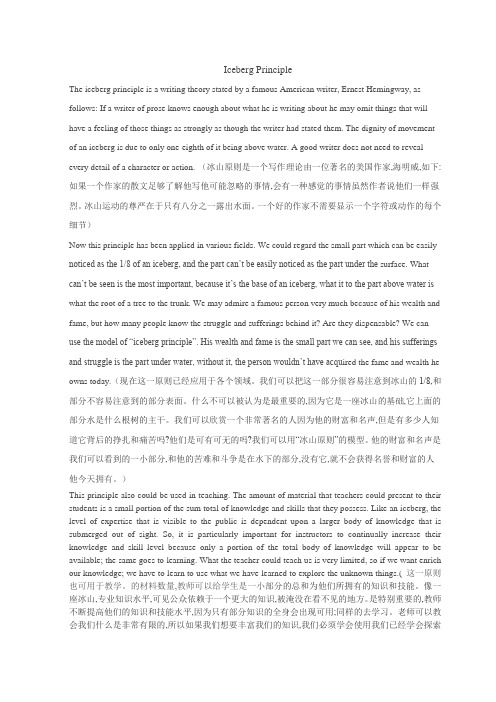
Iceberg PrincipleThe iceberg principle is a writing theory stated by a famous American writer, Ernest Hemingway, as follows: If a writer of prose knows enough about what he is writing about he may omit things that will have a feeling of those things as strongly as though the writer had stated them. The dignity of movement of an iceberg is due to only one-eighth of it being above water. A good writer does not need to reveal every detail of a character or action. (冰山原则是一个写作理论由一位著名的美国作家,海明威,如下:如果一个作家的散文足够了解他写他可能忽略的事情,会有一种感觉的事情虽然作者说他们一样强烈。
冰山运动的尊严在于只有八分之一露出水面。
一个好的作家不需要显示一个字符或动作的每个细节)Now this principle has been applied in various fields. We could regard the small part which can be easily noticed as the 1/8 of an iceberg, and the part can’t be easily noticed as the part under the surface. What can’t be seen is the most important, because it’s the base of an iceberg, what it to the part above water is what the root of a tree to the trunk. We may admire a famous person very much because of his wealth and fame, but how many people know the struggle and sufferings behind it? Are they dispensable? We can use the model of “iceberg principle”. His wealth and fame is the small part we can see, and his sufferings and struggle is the part under water, without it, the person wouldn’t have acqu ired the fame and wealth he owns today.(现在这一原则已经应用于各个领域。
简述冰山原则的主要内容
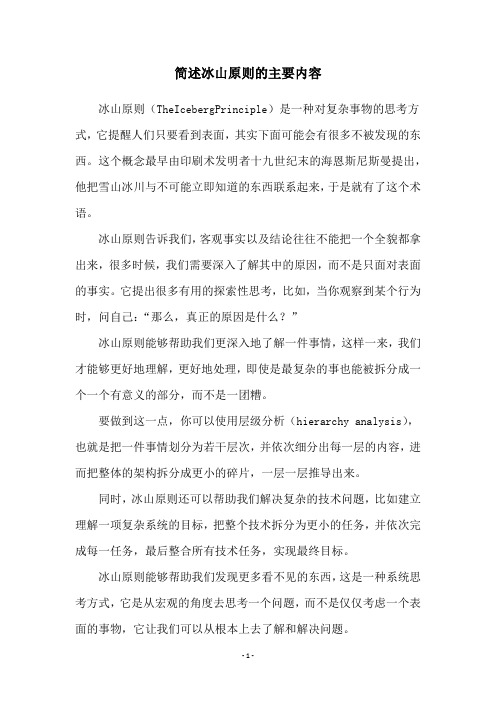
简述冰山原则的主要内容
冰山原则(TheIcebergPrinciple)是一种对复杂事物的思考方式,它提醒人们只要看到表面,其实下面可能会有很多不被发现的东西。
这个概念最早由印刷术发明者十九世纪末的海恩斯尼斯曼提出,他把雪山冰川与不可能立即知道的东西联系起来,于是就有了这个术语。
冰山原则告诉我们,客观事实以及结论往往不能把一个全貌都拿出来,很多时候,我们需要深入了解其中的原因,而不是只面对表面的事实。
它提出很多有用的探索性思考,比如,当你观察到某个行为时,问自己:“那么,真正的原因是什么?”
冰山原则能够帮助我们更深入地了解一件事情,这样一来,我们才能够更好地理解,更好地处理,即使是最复杂的事也能被拆分成一个一个有意义的部分,而不是一团糟。
要做到这一点,你可以使用层级分析(hierarchy analysis),也就是把一件事情划分为若干层次,并依次细分出每一层的内容,进而把整体的架构拆分成更小的碎片,一层一层推导出来。
同时,冰山原则还可以帮助我们解决复杂的技术问题,比如建立理解一项复杂系统的目标,把整个技术拆分为更小的任务,并依次完成每一任务,最后整合所有技术任务,实现最终目标。
冰山原则能够帮助我们发现更多看不见的东西,这是一种系统思考方式,它是从宏观的角度去思考一个问题,而不是仅仅考虑一个表面的事物,它让我们可以从根本上去了解和解决问题。
总而言之,冰山原则为我们提供了一种思考与解决复杂问题的方式,它给我们的思考带来了深度,让我们可以更好地去理解和解决问题,拆分解决复杂的技术问题,实现他们的目标。
通过学习冰山原则,我们能更加有力地处理复杂的现实问题,更好地获取宏观上的见解。
Iceberg-Principle冰山原则
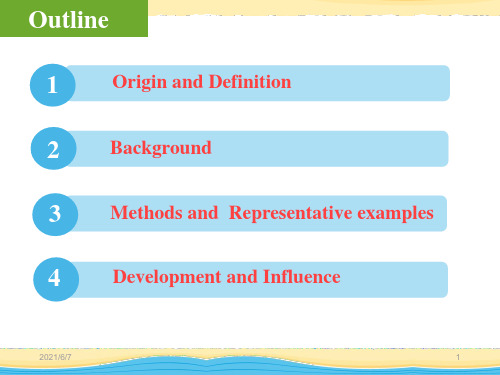
2021/6/7
12
Reprezentative examples
"You could omit anything if you knew that you omitted and the omitted part would strengthen the story and make people feel something more than they understood."2021/6 Nhomakorabea78
Methods and Reprezentative
3
Examples
2021/6/7
9
Methods
He emphSaysmizebsotlhisemro--le象o征f im手pl法ication, which is, in fact, the basis
of his works, in which he would leave out essential
战后青年对人生万念俱灰,及时行乐的主题凸现出来
2021/6/7
15
Reprezentative examples
《老人与海》: 海明威对象征手法的运用在这里已经成为一
种自觉。如:大海象征着所有人面临的变化无常的 神秘处境,马林鱼象征着人生的目标,鲨鱼象征着 永远无法摆脱的暴力与悲剧,多次出现于老人梦中 的狮子象征着勇气与力量,老人桑迪亚哥则象征着 “完全哲理化人类形象和人类精神。”这些渲染人 类社会的生存氛围,凸显了《老人与海》的主题。
冰山原则名词解释
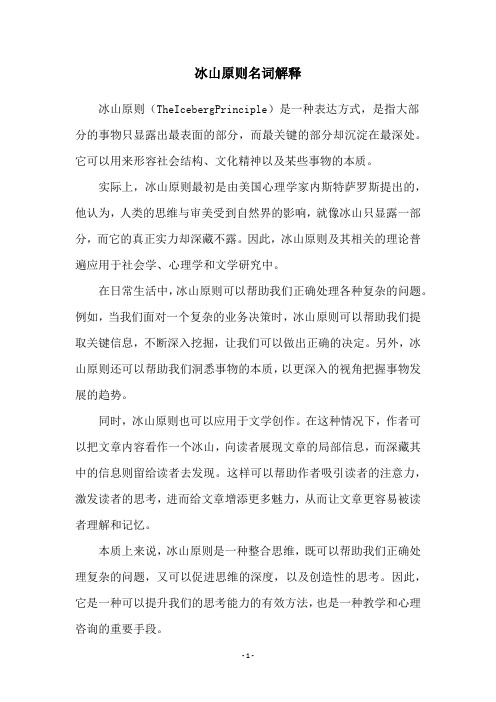
冰山原则名词解释
冰山原则(TheIcebergPrinciple)是一种表达方式,是指大部
分的事物只显露出最表面的部分,而最关键的部分却沉淀在最深处。
它可以用来形容社会结构、文化精神以及某些事物的本质。
实际上,冰山原则最初是由美国心理学家内斯特萨罗斯提出的,他认为,人类的思维与审美受到自然界的影响,就像冰山只显露一部分,而它的真正实力却深藏不露。
因此,冰山原则及其相关的理论普遍应用于社会学、心理学和文学研究中。
在日常生活中,冰山原则可以帮助我们正确处理各种复杂的问题。
例如,当我们面对一个复杂的业务决策时,冰山原则可以帮助我们提取关键信息,不断深入挖掘,让我们可以做出正确的决定。
另外,冰山原则还可以帮助我们洞悉事物的本质,以更深入的视角把握事物发展的趋势。
同时,冰山原则也可以应用于文学创作。
在这种情况下,作者可以把文章内容看作一个冰山,向读者展现文章的局部信息,而深藏其中的信息则留给读者去发现。
这样可以帮助作者吸引读者的注意力,激发读者的思考,进而给文章增添更多魅力,从而让文章更容易被读者理解和记忆。
本质上来说,冰山原则是一种整合思维,既可以帮助我们正确处理复杂的问题,又可以促进思维的深度,以及创造性的思考。
因此,它是一种可以提升我们的思考能力的有效方法,也是一种教学和心理咨询的重要手段。
总而言之,冰山原则是一种重要的概念,它不仅可以帮助我们处理复杂的问题,还可以给思维带来更大的深度,对提升能力具有重要的作用。
尽管冰山原则本质上只是一种表达方式,但它却是我们处理复杂问题以及思考深度的重要指南。
事故损失冰山原则直接成本

事故损失冰山原则直接成本事故损失冰山原则直接成本引言:事故损失冰山原则是一个在风险管理和事故调查领域被广泛应用的概念。
这个原则表明,在一个事故中,直接造成损失的事件,只是整个事故的一小部分,就像冰山的露出水面一样,剩下的部分在水下。
直接成本是指与事故直接相关的损失,它们往往容易被量化和注意到,但是间接成本和隐含成本则往往被低估或忽视。
本文将深入探讨事故损失冰山原则直接成本的影响和重要性,并从多个角度对其进行评估。
一、事故损失冰山原则的定义和背景(介绍主题)事故损失冰山原则是根据冰山的形象而得名的,冰山只露出水面的一小部分,而大部分则在水下。
事故损失也如此,只有一小部分是直接可见的,而大部分则是间接的或者隐藏的。
直接成本是与事故直接相关的损失,包括物质损失、人员伤亡和停工造成的损失。
这些损失容易被量化和注意到,但是其他的损失则往往被忽视。
了解和评估事故损失冰山原则,并将其应用于风险管理和事故调查中,可以更全面地理解事故的影响,并采取适当的措施来预防和减少风险。
二、事故损失冰山原则中的直接成本评估(从浅入深)1. 物质损失的直接成本评估:物质损失是事故中最直接和易于量化的部分。
评估物质损失的直接成本需要考虑损失的价值和代替成本。
价值损失是指物质损失的财务价值,如设备、车辆等的损坏损失。
代替成本是指恢复或替代损坏物品所需的成本,包括修理费用、替代设备的购买成本等。
通过准确评估物质损失的直接成本,可以为事故调查和风险管理提供重要的参考依据。
2. 人员伤亡的直接成本评估:人员伤亡是事故中最令人关切的部分,评估人员伤亡的直接成本涉及到医疗费用、赔偿费用和丧失的劳动力等。
医疗费用包括救治费用、住院费用和康复费用等。
赔偿费用则是指赔偿伤者及其家属的经济和精神损失,如丧失劳动能力带来的收入减少、精神抚慰费用等。
在人员伤亡的直接成本评估中,除了经济损失外,还需要考虑人的生命价值和社会心理因素的影响。
3. 停工造成的直接成本评估:事故导致的停工是一个常见的直接损失,它会导致生产的中断和损失的加剧。
“冰山原则”的四个维度
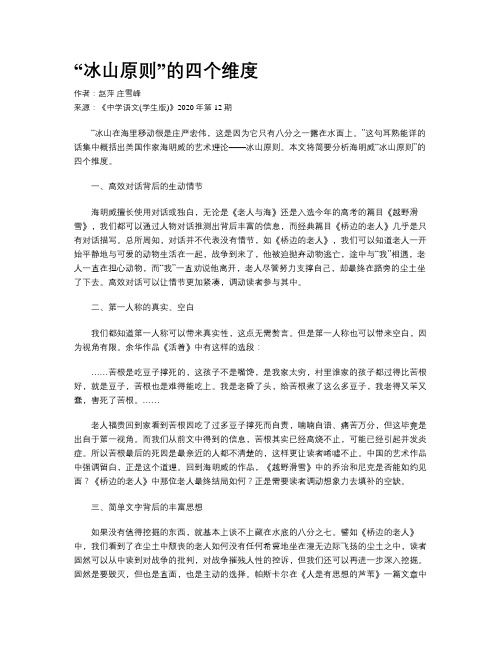
“冰山原则”的四个维度作者:赵萍庄雪峰来源:《中学语文(学生版)》2020年第12期“冰山在海里移动很是庄严宏伟,这是因为它只有八分之一露在水面上。
”这句耳熟能详的话集中概括出美国作家海明威的艺术理论——冰山原则。
本文将简要分析海明威“冰山原则”的四个维度。
一、高效对话背后的生动情节海明威擅长使用对话或独白,无论是《老人与海》还是入选今年的高考的篇目《越野滑雪》,我们都可以通过人物对话推测出背后丰富的信息,而经典篇目《桥边的老人》几乎是只有对话描写。
总所周知,对话并不代表没有情节,如《桥边的老人》,我们可以知道老人一开始平静地与可爱的动物生活在一起,战争到来了,他被迫抛弃动物逃亡,途中与“我”相遇,老人一直在担心动物,而“我”一直劝说他离开,老人尽管努力支撑自己,却最终在路旁的尘土坐了下去。
高效对话可以让情节更加紧凑,调动读者参与其中。
二、第一人称的真实、空白我们都知道第一人称可以带来真实性,这点无需赘言。
但是第一人称也可以带来空白,因为视角有限。
余华作品《活着》中有这样的选段:……苦根是吃豆子撑死的,这孩子不是嘴馋,是我家太穷,村里谁家的孩子都过得比苦根好,就是豆子,苦根也是难得能吃上。
我是老昏了头,给苦根煮了这么多豆子,我老得又笨又蠢,害死了苦根。
……老人福贵回到家看到苦根因吃了过多豆子撑死而自责,喃喃自语、痛苦万分,但这毕竟是出自于第一视角。
而我们从前文中得到的信息,苦根其实已经高烧不止,可能已经引起并发炎症。
所以苦根最后的死因是最亲近的人都不清楚的,这样更让读者唏嘘不止。
中国的艺术作品中强调留白,正是这个道理。
回到海明威的作品,《越野滑雪》中的乔治和尼克是否能如约见面?《桥边的老人》中那位老人最终结局如何?正是需要读者调动想象力去填补的空缺。
三、简单文字背后的丰富思想如果没有值得挖掘的东西,就基本上谈不上藏在水底的八分之七。
譬如《桥边的老人》中,我们看到了在尘土中颓丧的老人如何没有任何希冀地坐在漫无边际飞扬的尘土之中,读者固然可以从中读到对战争的批判,对战争摧残人性的控诉,但我们还可以再进一步深入挖掘。
(完整版)冰山理论

冰山理论“冰山理论”是根据弗洛伊德、海明威和萨提亚在各自领域将“冰山理论”提出并加以应用到心理学界、文学界、管理学界、医学界等,传播广泛。
1932年,海明威在他的纪实性作品《午后之死》中,提出著名的“冰山原则”。
他以“冰山”为喻,认为作者只应描写“冰山”露出水面的部分,水下的部分应该通过文本的提示让读者去想像补充。
他说:“冰山运动之雄伟壮观,是因为他只有八分之一在水面上。
”文学作品中,文字和形象是所谓的“八分之一”,而情感和思想是所谓的“八分之七”。
前两者是具体可见的,后两者是寓于前两者之中的。
“冰山理论”有两个层面的含义: 一是简约的艺术。
即删掉小说中一切可有可无的东西,以少胜多,象中国水墨画技巧,计白当黑,不要铺陈,不要八分之八,而只要八分之一。
英国学者贝茨在《海明威的短篇小说》一文中认为,这种简约在语言上表现为删掉了小说中几乎所有的解释、探讨,甚至议论;砍掉了一切花花绿绿的比喻;剥下了亨利·詹姆斯时代句子长、形容词多得要命的华丽外衣:“他以谁也不曾有过的勇气把英语中附着于文学的乱毛剪了个干净。
”这些英语文学的乱毛中被海明威收拾得最利索的是形容词。
形容词过多是十九世纪末以亨利·詹姆斯为代表的小说家带给英语文学的一大灾难。
譬如詹姆斯的代表作《贵妇人的画像》充斥了长句子和多重修饰,“你不憋足一口长气是读不完一个句子的,好比一长列货车,站在它面前望不到尽头”(董衡巽语)。
这绝对是学者型的文风。
而海明威18岁就去打仗,根本没有机会进行科班训练,打过仗当了美国一家报纸驻欧洲的记者,写文章和报道要用电报发回国,语言必须简明,于是形成了一种所谓的“电报体风格”,极少用修饰语,极少用形容词。
可以说文学史上有一类作家是敌视形容词的。
法国大文豪伏尔泰就有句名言:“形容词是名词的敌人。
”他似乎在说只有名词是直抵事物本身,是直面、直接呈示事物,形容词多了反而遮蔽事物和内质,所以是名词的敌人。
其二,小说家马原认为“冰山理论”的更内在的质素可以概括为“经验省略”。
冰山理论中英
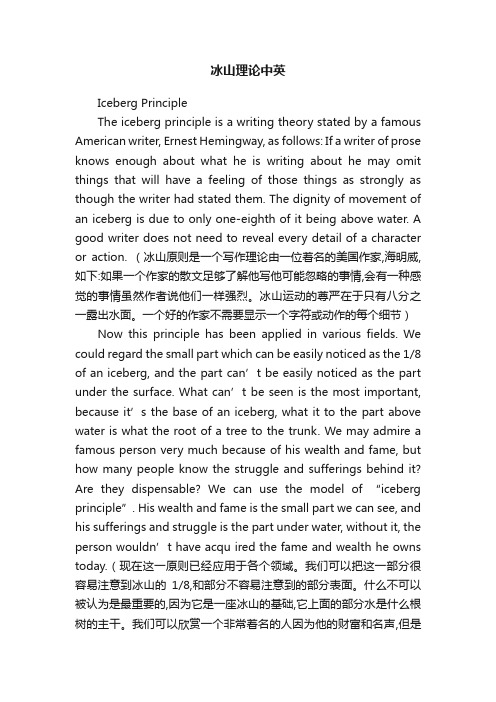
冰山理论中英Iceberg PrincipleThe iceberg principle is a writing theory stated by a famous American writer, Ernest Hemingway, as follows: If a writer of prose knows enough about what he is writing about he may omit things that will have a feeling of those things as strongly as though the writer had stated them. The dignity of movement of an iceberg is due to only one-eighth of it being above water. A good writer does not need to reveal every detail of a character or action. (冰山原则是一个写作理论由一位着名的美国作家,海明威,如下:如果一个作家的散文足够了解他写他可能忽略的事情,会有一种感觉的事情虽然作者说他们一样强烈。
冰山运动的尊严在于只有八分之一露出水面。
一个好的作家不需要显示一个字符或动作的每个细节)Now this principle has been applied in various fields. We could regard the small part which can be easily noticed as the 1/8 of an iceberg, and the part can’t be easily noticed as the part under the surface. What can’t be seen is the most important, because it’s the base of an iceberg, what it to the part above water is what the root of a tree to the trunk. We may admire a famous person very much because of his wealth and fame, but how many people know the struggle and sufferings behind it? Are they dispensable? We can use the model of “iceberg principle”. His wealth and fame is the small part we can see, a nd his sufferings and struggle is the part under water, without it, the person wouldn’t have acqu ired the fame and wealth he owns today.(现在这一原则已经应用于各个领域。
iceberg格式
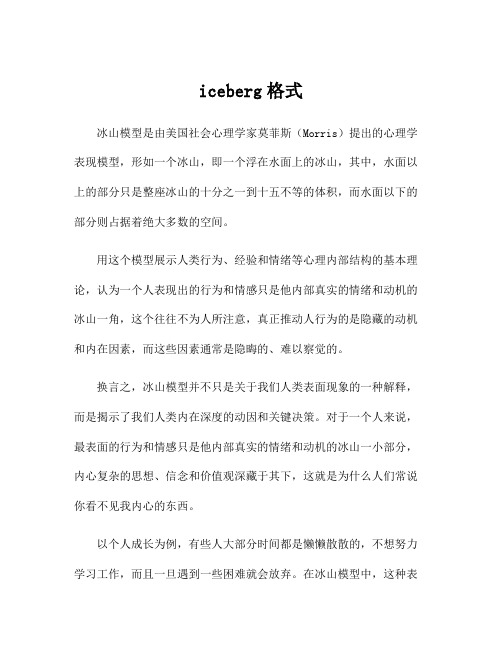
iceberg格式冰山模型是由美国社会心理学家莫菲斯(Morris)提出的心理学表现模型,形如一个冰山,即一个浮在水面上的冰山,其中,水面以上的部分只是整座冰山的十分之一到十五不等的体积,而水面以下的部分则占据着绝大多数的空间。
用这个模型展示人类行为、经验和情绪等心理内部结构的基本理论,认为一个人表现出的行为和情感只是他内部真实的情绪和动机的冰山一角,这个往往不为人所注意,真正推动人行为的是隐藏的动机和内在因素,而这些因素通常是隐晦的、难以察觉的。
换言之,冰山模型并不只是关于我们人类表面现象的一种解释,而是揭示了我们人类内在深度的动因和关键决策。
对于一个人来说,最表面的行为和情感只是他内部真实的情绪和动机的冰山一小部分,内心复杂的思想、信念和价值观深藏于其下,这就是为什么人们常说你看不见我内心的东西。
以个人成长为例,有些人大部分时间都是懒懒散散的,不想努力学习工作,而且一旦遇到一些困难就会放弃。
在冰山模型中,这种表现只是这个人内部的因素之一,其它隐藏因素可能包括他潜意识中也许并不喜欢所在的工作,抵触学习和锻炼等。
再看情绪管理方面,冰山模型的表现也十分真实。
虽然一个人可能会抱怨情绪管理十分困难,但事实上真正挑战的是潜意识的决定及其变化。
我们的情绪往往是由许多难以察觉的隐含反应组成的,例如死亡、社会热点和紧张等一个人的反应会被时而隐藏的决定所驱使,那么如果人们能够找出热议话题(例如教育、药品、漏税等)在他们内心的底层逻辑,便可以更好的理解为什么他们如此感慨。
同时,这种内在因素对我们人生的重大决策也有很大影响。
比如我们经常会有选择大学、职业等大事的问题,但事实上,我们的内心价值观和信仰似乎更为重要。
外在表象的改变、他人的建议甚至是医生的诊断都不如自己内心的信仰,如果你找到了那些价值观和信仰,你也许就找到了人生最为坚强的支撑。
有时候,人的内心藏得很浅,看似丰富却找不到真正能摸到的关键所在。
冰山模型则提供了这样一种透视角度,让我们站在另一个角度去看待人的行为和情感,从而能更深层次地理解人的内心,以促进我们更好的沟通和理解。
从《老人与海》看海明威的“冰山原则”
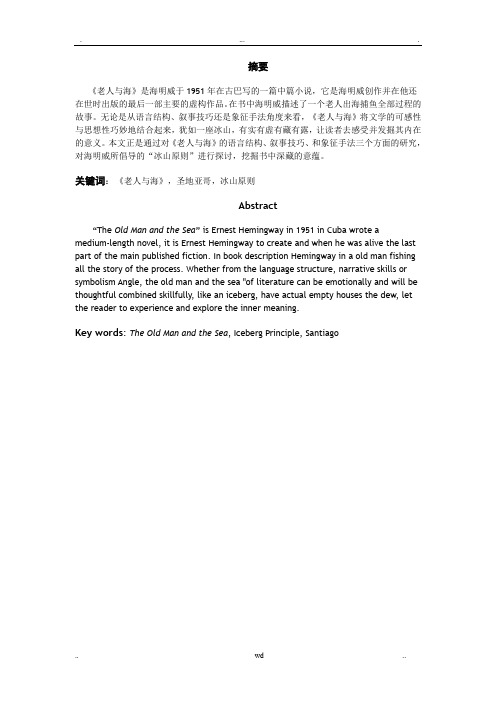
. ... .摘要《老人与海》是海明威于1951年在古巴写的一篇中篇小说,它是海明威创作并在他还在世时出版的最后一部主要的虚构作品。
在书中海明威描述了一个老人出海捕鱼全部过程的故事。
无论是从语言结构、叙事技巧还是象征手法角度来看,《老人与海》将文学的可感性与思想性巧妙地结合起来,犹如一座冰山,有实有虚有藏有露,让读者去感受并发掘其内在的意义。
本文正是通过对《老人与海》的语言结构、叙事技巧、和象征手法三个方面的研究,对海明威所倡导的“冰山原则”进行探讨,挖掘书中深藏的意蕴。
关键词:《老人与海》,圣地亚哥,冰山原则Abstract“The Old Man and the Sea” is Ernest Hemingway in 1951 in Cuba wrote amedium-length novel, it is Ernest Hemingway to create and when he was alive the last part of the main published fiction. In book description Hemingway in a old man fishing all the story of the process. Whether from the language structure, narrative skills or symbolism Angle, the old man and the sea "of literature can be emotionally and will be thoughtful combined skillfully, like an iceberg, have actual empty houses the dew, let the reader to experience and explore the inner meaning.Key words:The Old Man and the Sea, Iceberg Principle, Santiago目录绪论 (III)一、语言、结构简练直白却富有深蕴 (IV)(一)平实的语言带深厚意蕴 (IV)(二)结构凝练,能省即省 (V)二、叙事技巧 (VII)三、象征手法的运用 (VIII)(一)孩子的象征意义 (VIII)(二)大马林鱼的象征意义 (VIII)(三)狮子的象征意义 (IX)结论 (X)参考文献: (XI)致谢 (XII)绪论厄内斯特·海明威(1899—1961)作为二十世纪美国最著名的作家之一,尤其以精湛的叙事艺术见长。
iceberg timeline 原理
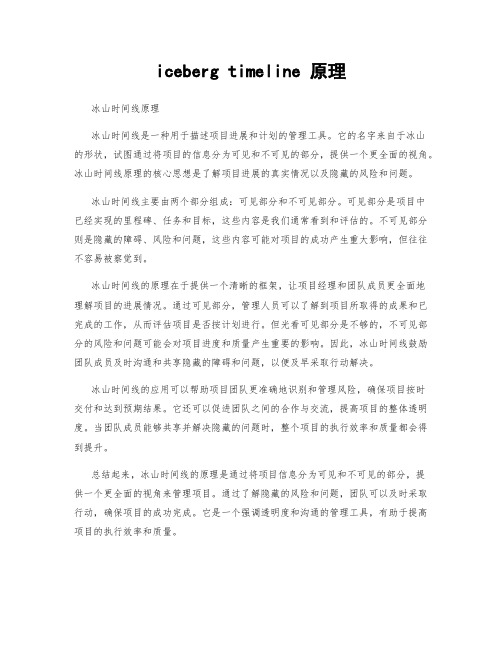
iceberg timeline 原理
冰山时间线原理
冰山时间线是一种用于描述项目进展和计划的管理工具。
它的名字来自于冰山
的形状,试图通过将项目的信息分为可见和不可见的部分,提供一个更全面的视角。
冰山时间线原理的核心思想是了解项目进展的真实情况以及隐藏的风险和问题。
冰山时间线主要由两个部分组成:可见部分和不可见部分。
可见部分是项目中
已经实现的里程碑、任务和目标,这些内容是我们通常看到和评估的。
不可见部分则是隐藏的障碍、风险和问题,这些内容可能对项目的成功产生重大影响,但往往不容易被察觉到。
冰山时间线的原理在于提供一个清晰的框架,让项目经理和团队成员更全面地
理解项目的进展情况。
通过可见部分,管理人员可以了解到项目所取得的成果和已完成的工作,从而评估项目是否按计划进行。
但光看可见部分是不够的,不可见部分的风险和问题可能会对项目进度和质量产生重要的影响。
因此,冰山时间线鼓励团队成员及时沟通和共享隐藏的障碍和问题,以便及早采取行动解决。
冰山时间线的应用可以帮助项目团队更准确地识别和管理风险,确保项目按时
交付和达到预期结果。
它还可以促进团队之间的合作与交流,提高项目的整体透明度。
当团队成员能够共享并解决隐藏的问题时,整个项目的执行效率和质量都会得到提升。
总结起来,冰山时间线的原理是通过将项目信息分为可见和不可见的部分,提
供一个更全面的视角来管理项目。
通过了解隐藏的风险和问题,团队可以及时采取行动,确保项目的成功完成。
它是一个强调透明度和沟通的管理工具,有助于提高项目的执行效率和质量。
iceberg principle英文解释
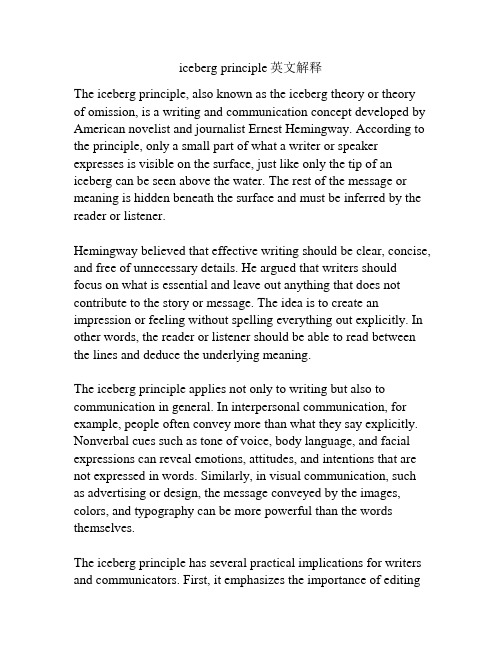
iceberg principle英文解释The iceberg principle, also known as the iceberg theory or theoryof omission, is a writing and communication concept developed by American novelist and journalist Ernest Hemingway. According to the principle, only a small part of what a writer or speaker expresses is visible on the surface, just like only the tip of an iceberg can be seen above the water. The rest of the message or meaning is hidden beneath the surface and must be inferred by the reader or listener.Hemingway believed that effective writing should be clear, concise, and free of unnecessary details. He argued that writers should focus on what is essential and leave out anything that does not contribute to the story or message. The idea is to create an impression or feeling without spelling everything out explicitly. In other words, the reader or listener should be able to read between the lines and deduce the underlying meaning.The iceberg principle applies not only to writing but also to communication in general. In interpersonal communication, for example, people often convey more than what they say explicitly. Nonverbal cues such as tone of voice, body language, and facial expressions can reveal emotions, attitudes, and intentions that are not expressed in words. Similarly, in visual communication, such as advertising or design, the message conveyed by the images, colors, and typography can be more powerful than the words themselves.The iceberg principle has several practical implications for writers and communicators. First, it emphasizes the importance of editingand revision. Just as an artist must chisel away at a block of stone to reveal the statue hidden within, a writer must cut away unnecessary words and clarify the message to make it more effective. Second, it underscores the importance of audience analysis. Writers and communicators must consider the perspective and background of their audience to ensure that the message is conveyed clearly and appropriately. Third, it highlights the power of suggestion. By leaving some things unsaid and trusting the reader or listener to infer the meaning, a writer or speaker can create a more engaging and memorable experience.To summarize, the iceberg principle is a writing and communication concept that emphasizes the importance of clarity, concision, and omission. It suggests that only a small part of a message is visible on the surface, and that the rest must be inferred by the reader or listener. By applying this principle to their work, writers and communicators can create more powerful and engaging messages that resonate with their audience.。
海明威冰山原理名词解释
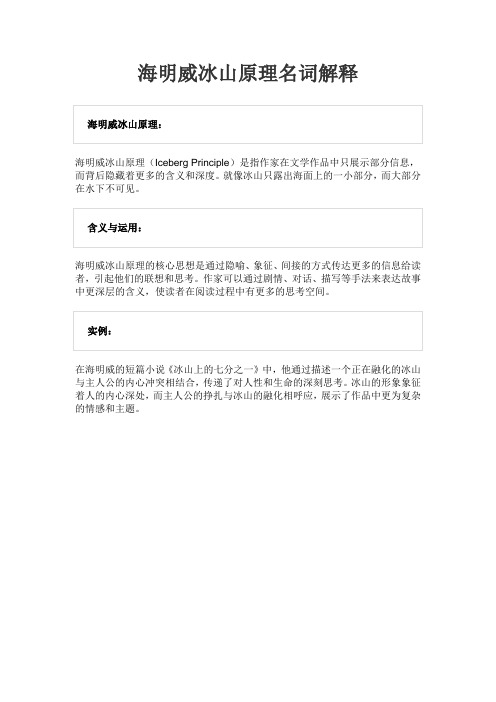
海明威冰山原理名词解释
海明威冰山原理(Iceberg Principle)是指作家在文学作品中只展示部分信息,而背后隐藏着更多的含义和深度。
就像冰山只露出海面上的一小部分,而大部分在水下不可见。
海明威冰山原理的核心思想是通过隐喻、象征、间接的方式传达更多的信息给读者,引起他们的联想和思考。
作家可以通过剧情、对话、描写等手法来表达故事中更深层的含义,使读者在阅读过程中有更多的思考空间。
在海明威的短篇小说《冰山上的七分之一》中,他通过描述一个正在融化的冰山与主人公的内心冲突相结合,传递了对人性和生命的深刻思考。
冰山的形象象征着人的内心深处,而主人公的挣扎与冰山的融化相呼应,展示了作品中更为复杂的情感和主题。
试析海明威得冰山原则

试析海明威得冰山原则摘要:海明威创作遵循的“冰山”原则,就是用“八分之七”作为基础来表“八分之一”,用简洁的语言表达深刻的内涵,用富有深蕴的象征表现他对人生、人类命运的思考。
《老人与海》集中体现了这一创作原则。
关键词:《老人与海》冰山原则省略一、引言作为美国文学史上“第二次繁荣”的代表性作家,厄内斯特·海明威(1899——1961)以其独树一帜的创作风格和他小说中所塑造的一系列的“硬汉子”形象在美国乃至世界文坛上占有着相当重要的地位。
他被誉为“开一代文风”,甚至“引起了一场文学革命”,对现代英美文学产生了长久深远的影响。
1932年,海明威在他的作品《午后之死》中第一次提出文学创作的“冰山”原则:“i always try to write on the principle of the iceberg. there is seven-eighths of it under water for every part that shows. anything you know you can eliminate and it only strengths your iceberg. it is the part that doesn’t show.”我们可以试着将此原则用以下语言解释:最大限度地将作者的感情埋藏在简单精炼的语言之下,从而激发读者通过鲜明的描述来感觉和想象文本的真正意义所在。
读者所能看到的和所能计算的体积只是露出海面的冰山一角,隐藏在海水深处的才真正是冰山的全部,而这一部分只能让读者去感受、猜测和想象。
而这种写作风格在《老人与海》(the old men and the sea)更是达到了炉火纯青的地步。
二、丰富的生活积累要表现“八分之一”,就要有“八分之七”作为基础。
海明威传奇式的生活给了他非常多的生活素材。
因此,他笔下都是他所见所闻或亲身经历的一些事情。
《老人与海》这部作品就取材于他在古巴渔村生活时了解到的一个真实的故事:“一天清晨,我在海滩的水边上,准备驾驶‘拜勒号’出海玩一天。
Iceberg Principle冰山原则 ppt课件
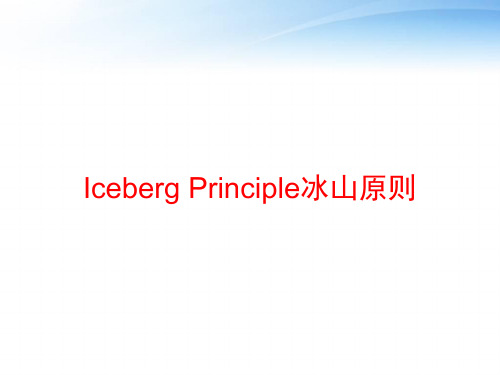
Iceberg Principle
“冰山原则”创作理论
Outline
1
Origin and Definition
2
Background
3
Methods and Representative examples
4
Development and Influence
Background
Being a reporter laid a good foundation for Hemingway’s “iceberg principle”. His terseness and accuracy had some in common with the language used in news report. Nevertheless, he didn’t lose his personality in such a strict regulations of words, on the contrary he created his own special language style.
--Ernest Hemingway in the Death in the Afternoon
Definition
The theory of omission
所谓“冰山原则”,就 是用简洁的文字塑造出鲜明 的形象,把自身的感受和思 想情绪最大限度的埋藏在形 象之中,使之情感充沛却含 而不露、思想深沉而隐而不 晦,从而将文学的可感性与 可思性巧妙的结合起来,让 读者对鲜明形象的感受去发 掘作品的思想意义。
Methods and Reprezentative
3
Examples
- 1、下载文档前请自行甄别文档内容的完整性,平台不提供额外的编辑、内容补充、找答案等附加服务。
- 2、"仅部分预览"的文档,不可在线预览部分如存在完整性等问题,可反馈申请退款(可完整预览的文档不适用该条件!)。
- 3、如文档侵犯您的权益,请联系客服反馈,我们会尽快为您处理(人工客服工作时间:9:00-18:30)。
clear prose based on action rather than reflection. He also
节号的作用,它省略的是情味和韵致;而海明威省略的则是完
全不同质的东西——实体经验。这种“经验省略”涉及的决不 仅仅是个“简洁”的问题,它还关涉着对世界的认知与呈示问
题,关涉着小说家对生活中的情境和境遇的传达方式问题,从
中有可能生成一种小说的情境美学。
Influence
Hemingway pioneered a new style of writing that is almost
beings. Wars contributed to Hemingway’s basic
views on the human society and as well set a dull
and gloomy tone for his early works.
Background
Being a reporter laid a good foundation for
those things as strongly as though the writer had stated them.
The dignity of movement of an ice-berg is due to only one-eighth of it being above water. A writer who omits things because he dose not know them only makes hollow places in his writing. --Ernest Hemingway in the Death in the Afternoon
情感和思想的含蓄性。
2
Background
Background
The need to completely change the florid style of
literature in the 19th century Victorian era.
Hemingway’s years’ life experiences and his way of thinking about lives. In Hemingway’s point of view, wars, succeeded by an unstable society, brought about unprecedented disasters to human
Reprezentative examples
《白象似的群山》:
小说讲述一对男女恋人在车站酒巴等火车时 , 两人之 间的一些对话 。 最初从他们的对话中 , 我们看到这一对 男女青年之间并没有什么隔阂 , 甚至是很友好 。姑娘说 要喝啤酒 , 男人马上吩咐要两大杯 ; 姑娘想尝尝掺了水 的茴香酒 , 男人马上让酒保照办 。在之后的对话中 , 我 们似乎感到了男女的分歧 : 女人总是眺望远方 , 看到远 处的群山像一群白象 ; 而男人更关心的是让女人去手术 。 这种分歧只是在平平淡淡中发生的 , 好象也没有什么真正 的矛盾冲突 。
Iceberg Principle
海明威的“冰山原则”创作理论
Outline
1 2 3 4
Origin and Definition
Background Methods and Representative examples Development and Influence
1
Origin and Definition
Origin
If a writer of prose knows enough of what he is writing about, he may omit things that he knows and the reader, if the writer is writing truly enough, will have a feeling of
“完全哲理化人类形象和人类精神。”这些渲染人
类社会的生存氛围,凸显了《老人与海》的主题。
3
Development and Influence
Development
“A few things I have found to be true. If you leave out important things or events that you know about, the story is strengthened. If you leave or skip something because you do not know it, the story will be worthless. The test of any story is how very good the stuff that you, not your editors, omit." "You could omit anything if you knew that you omitted and the omitted part would strengthen the story and make people
的思想是构成”冰山原则”的四个基本要素。具体 地说,文字和形象是所谓的“八分之一”,而情感 和思想是所谓的“八分之七”。前两者是具体可见 的,后两者是寓于前两者之中的。文字塑造了形象,
形象包含了情感,而情感之中蕴涵着思想。诚然,
就一般文作品而言,这四个要素都是必不可少的,
但在海明威的作品中显得尤为突出,因为他强调了
Reprezentative examples
“我说我们本来可以舒舒服服享受生活中的一切 。 ”
“我们能够做到这一点的 。 ” “不 , 我们不能 。 ”
“我们可以拥有整个世界 。 ”
“不 , 我们不能 。 ” “我们可以到处去逛逛 。 ”
“不 , 我们不能 , 这个世界不再是我们的 。 ”
“我觉得好极了。”她说,“我又没有什么毛病罗。我觉得好极了”
his own special language style.
3
Methods and Reprezentative Examples
Methods
Symbolism-象征手法 He emphasizes the role of implication, which is, in fact, the basis
employed a technique by which he would leave out essential information of the story under the belief that omission can sometimes add strength to a narrative. It was a style of subtlety which contrasted greatly (and in a way enhanced) the themes he wrote about...war, blood sports like owe a debt of influence to Hemingway. bullfighting or boxing, crime, etc. It is hard to find anyone writing today who doesn't
战后青年对人生万念俱灰,及时行乐的主题凸现出来
Reprezentative examples
《老人与海》:
海明威对象征手法的运用在这里已经成为一
种自觉。如:大海象征着所有人面临的变化无常的 神秘处境,马林鱼象征着人生的目标,鲨鱼象征着
永远无法摆脱的暴力与悲剧,多次出现于老人梦中
的狮子象征着勇气与力量,老人桑迪亚哥则象征着
Manmore with an axe--拿着板斧的人(简练文风) direct emotion, sincerity, realism and
简洁直白的文字塑造了形象,白描式的形象包含
了丰富的情感,而情感之中蕴涵着深刻的思想。
Methods
海明威的“冰山原则”首先表现在对语言的运用上,即简约 的文字。在容易被读者察觉的“八分之一”的文字表达里, 客观的叙述,直观的描写,将文字节俭到吝啬的地步。在海 明威的作品中,我们见不到过多的形容词、副词等修饰性言 辞。他总是用近乎直白的描述,展示人物及人物的处境,利 用名词的准确性和动词的生动性刻画其人物,使读者根据自
Hemingway’s “iceberg principle”. His terseness
and accuracy had some in common with the language used in news report. Nevertheless, he didn’t lose his personality in such a strict regulations of words, on the contrary he created
feel something more than they understood."
--Ernest Heimingway The Art of the Short Story
Development
小说家马原认为“冰山理论”的更内在的质素可以概括为 “经验省略”。他指出开始许多评论家把海明威的省略与传统 的留空白理论等同起来,以为这是一种含蓄手法的运用,言有 尽而意无穷,这是一个大的失误。传统的省略方法很类似于删
